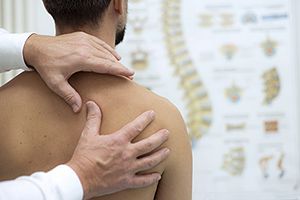Some doctors thrive in a personality-based clinic and have a loyal following no matter what services or equipment they offer, but for most chiropractic offices who are trying to grow and expand, new equipment purchases help us stay relevant and continue to service our client base in the best, most up-to-date manner possible. So, regarding equipment purchasing: should you lease, get a bank loan, or pay cash?
Your Most Important Step in Accurate Shoulder Diagnosis
In this month's column, let's cover key aspects of the presenting history for patients with shoulder complaints. As a lead-in to this, it is essential to remind everyone of the intricacies of the shoulder.
The shoulder can be described as a complex and as complex. It is a complex as it pertains to many different connected parts (multiple interacting joints). It is complex as it pertains to something difficult to understand.
Essential Shoulder Anatomy
The shoulder complex consists of the glenohumeral, acromioclavicular and sternoclavicular joints. The scapulothoracic joint is considered by many to be a fourth joint in the complex, but a pseudo-joint by others. Regardless of the anatomical classifications, the shoulder complex cannot function correctly without the proper function of the scapulothoracic joint.
Knowledge of complex shoulder anatomy is vital to all neuromusculoskeletal practitioners. Anatomical knowledge is the precursor to gaining the clinical knowledge necessary to understand shoulder dysfunction. A review of shoulder anatomy in combination with this article would serve all practitioners well.
The History: Key to Diagnosis

Several components of an assessment are involved in developing an accurate diagnosis. History, physical examination and imaging all play valuable roles. Of these, history is often the most influential in the diagnostic process.
How a process starts is typically how a process ends. Starting with an accurate history usually leads to a precise diagnosis, proper treatment and appropriate recovery.
Much of the initial history for shoulder complaints is obtained through entrance information provided by the patient when they enter the office. The initial information recorded through entrance forms, kiosks and tablet software plays a prominent role in documenting the patient's status.
Age and Occupation
Entrance history begins with the patient listing age, occupation and side of handedness. The patient's age is of particular importance, as common pathologies tend to onset within specific age ranges (Table 1).
TABLE 1: AGE OF ONSET FOR COMMON SHOULDER PATHOLOGIES | |
Age | Pathology |
| Teens to 20s | Secondary impingements |
| Twenties to 30s | Calcium deposits |
| Over age 35 | Secondary impingements |
| Thirties to 40s | Chondrosarcoma |
| Mid-forties to 60 | Frozen shoulder |
| Forties to 60s | Rotator cuff degeneration |
The patient's occupation offers clues to what may have caused the presenting complaint. It also gives clues to difficulties the patient could experience during healing and rehabilitation.
The side of handedness provides additional hints. A person's dominant side is more likely to be overused or injured. Pathology of the dominant side can also call attention to difficulties a patient encounters during daily living activities.
Timing and Onset
The date and timing of onset are always necessary information to obtain. Rapid onset is usually associated with known trauma; however, rapid onset resulting from a minor event, in the absence of trauma, can indicate a problem that has been developing over time.
Onset can also be for "this episode" if the patient has had previous problems. This situation indicates an acute flare-up of a chronic condition. That said, always consider the possibility that a new pathology exists in addition to the chronic pathology. Shoulder conditions are often multifactorial, with different pathologies having been present for different periods of time.
Level and Quality of Pain
Assessing pain using a numerical pain scale (0-10) provides you with an idea of the patient's discomfort and dysfunction. When combined with other findings, the severity of pain also offers the opportunity to judge if the patient is overreacting or downplaying symptoms.
The quality of pain, what the pain feels like, often points to which tissues are pathological. (Table 2)
TABLE 2: SENSATIONS ASSOCIATED WITH PATHOLOGICAL TISSUES OF THE SHOULDER COMPLEX | |
Sensation | Tissue |
| Cramping, twitching, achy | Muscle |
| Dull, generalized, achy | Ligament, joint capsule |
| Sharp, shooting, numbness | Nerve root, nerve |
| Nagging, dull, deep | Bone |
| Sharp, severe, unrelenting | Fracture |
| Throbbing, pulsating | Vasculature |
The activities that increase or decrease pain must be recorded. This knowledge helps identify pathology based on function. Knowledge of activities that increase or decrease pain also provides information regarding the patient's degree of activity during household, occupational and recreational endeavors.
Paperwork or software that gives the patient the tools needed to mark a body diagram affords you further information about the location(s) of the patient's pain.
Other Considerations to Assess
Cancer: While tumors are not the most common reason for shoulder pain, primary and secondary tumors occur in the shoulder complex. Therefore, asking about previous cancer diagnoses is a requirement.
Surgery: Questions regarding surgical history will reveal any procedures performed in the past for the shoulder and related areas.
Anxiety / Depression: Questions during the entrance process should also ask about anxiety and depression. In my practice, one in three patients relates that they deal with anxiety and depression. The mind-body connection must not be downplayed. More than once in practice, I have encountered patients with shoulder complaints who made statements to the effect, "I cannot shoulder the responsibilities" or "You wouldn't believe the weight on my shoulders."
Mechanism of Injury: Question the patient extensively about the mechanism of injury. Sometimes the mechanism alone can be the most significant indicator of a distinct diagnosis.
Compensation: Is the patient holding or supporting the arm on the side of the complaint manually? How long has the antalgic posturing been present / necessary? Is the patient utilizing a sling or brace? Is the sling or brace self-prescribed or did another practitioner provide it? Is the sling or brace new or was it used during a previous episode?
Deficiencies: Does the patient report weakness of the shoulder region or arm? Is there a loss of grip strength? Is the deficiency or loss of strength only present with pain, or is it present even if the pain is intermittent?
Involvement: Are there other areas / regions involved? For example, numbness and weak pulse could indicate a form of thoracic outlet syndrome is present. Neck pain with radiation of pain below the elbow could indicate cervical radiculopathy.
Clinical Pearls
Review the information gained upon entry once the patient is transferred to an examination room. Requiring the patient to record most of the history saves the doctor and staff time. It also allows you to be prepared to move forward with other pertinent questions that require a greater deal of interpretation.
Remember, how you start is how you finish. Beginning with a solid history will increase your ability to diagnose and treat many common shoulder complaints. It will also help facilitate an appropriate referral when necessary. In any case, the true benefit will be to the patient.



